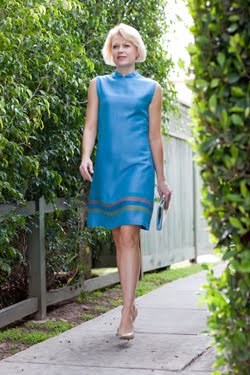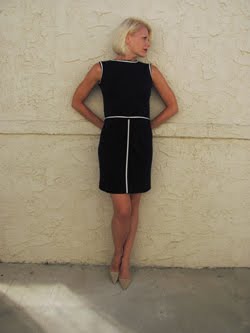It's fascinating how many of the films we now consider Christmas classics came from the 1940s. The decade began with the romances Remember the Night (1940) and The Shop Around the Corner (1940) as well as the witty The Man Who Came to Dinner (1942). But as the decade went on, World War II started to weave into the storylines in some way. Meet Me in St. Louis (1944) may have been set at the turn of the century, but the lyrics of Judy Garland's "Have Yourself a Merry Little Christmas" touched audiences torn apart by war. Frank Capra tapped into some of the angst of the post-war years with It's a Wonderful Life (1946). It Happened on Fifth Avenue (1947) showed soldiers trying to find shelter and work after the war. And the Civil War-era Little Women, remade in 1949 starring Janet Leigh, connected with families still struggling from World War II.
Holiday Affair premiered on Christmas Eve that same year and also explored some of the emotional aftermath of the war. Set in New York during the holidays, Leigh plays Connie Ennis, a war widow who's working as a comparative shopper to make ends meet. She runs into Robert Mitchum as Steve Mason, a veteran who dreams of building sailboats in Southern California, but temporarily works as a clerk at Crowley's department store. It's there that Steve catches Connie making an obvious purchase to take back to a rival store. But things really go awry when her son Timmy confuses her work purchase - an expensive train set - with a gift he expects under their Christmas tree. Because of that train, Steve eases into their life and finds himself falling for Connie. However, she already has a boyfriend (Wendell Corey) who has been working very hard (unsuccessfully) to get Connie to let go of the memory of her late husband and marry him.
Holiday Affair's backstory is as interesting as the film itself. In between the films noir Out of the Past (1947) and The Big Steal (1949) - both co-starring Jane Greer - Robert Mitchum was arrested for possession of marijuana. In September 1948, he and Lila Leeds were victims of a sting operation designed to capture Hollywood's hard partiers (you may know Lila as the shapely blonde secretary in the 1947 Christmas noir Lady in the Lake). By January of 1949, he was found guilty and spent 43 days in a Castaic prison farm. He was released at the end of March convinced his acting career was over. However, RKO head Howard Hughes had other ideas and cast Robert in Holiday Affair as a way to restore his bad boy image.
Robert Mitchum conversing with his attorney (above)
and standing before the judge with actress Lila Leeds
In contrast, Janet Leigh's image needed no revamping. Holiday Affair was part of her ascendance as a star. The origins of her film career are now a part of Hollywood legend. In 1946, Norma Shearer was vacationing at a ski resort in the Sierra Nevada mountains. Because Janet's parents worked there, a picture of the 19-year-old (then known as Jeannette Morrison) was among several taken by the ski club photographer. The smile of the girl in the photo - taken at Christmas time, no less - piqued the interest of the former Queen of MGM. Shearer immediately took Leigh under her wing and worked with agent Lew Wasserman to get the teenager a contract at her old home studio. Janet started working almost instantly, appearing in her first film The Romance of Rosy Ridge in 1947. Her performance in the 1948 noir Act of Violence was particularly well received and led into a pivotal year for the starlet. In 1949 she really started to shine, appearing in 5 films including Little Women and Holiday Affair.
The 1945 photo that captured Norma Shearer's attention (above)
and Norma with Janet at the premiere of The Romance of Rosy Ridge (1947)
Leigh was loaned to RKO for Holiday Affair rather than shooting it at MGM, and this allowed her to be in the hands of costume designer Howard Greer. Greer is one of the greats of Old Hollywood, best known for being the Chief Designer at Paramount during the 1920s. Like so many from this time who are celebrated for costume design, Howard started his career in the world of couture. In 1916, before America entered World War I, he worked at the international couturier Lucile in both Chicago and New York. He was drafted in 1917, and after the war designed for a time at Molyneux and Paul Poiret in Paris. Greer returned to America in 1919 and worked once again with Lucile's head Lady Duff-Gordon.
In 1922, Howard succeeded Clare West as head of costume design at Famous Players-Lasky, which would soon become Paramount. Travis Banton, his former colleague at Lucile, joined him in 1925 and their sophisticated designs would contribute to what was known as "Paramount Polish." By 1927, Greer decided to depart the studio to open his own boutique where he created couture for clients ranging from Ruby Keeler to Greta Garbo. However, he never really quit costume design and continued to freelance into the early 1950s. Some of his best work during this time includes Hell's Angels (1930) for Jean Harlow, Bringing Up Baby (1938) for Katharine Hepburn, Carefree (1938) for Ginger Rogers, and My Favorite Wife (1940) for Irene Dunne. His costumes can also be seen in the Deanna Durbin holiday film Lady on a Train (1945).
Howard Greer designed costumes for many films even after he left Paramount,
including this highly influential dress in the 1938 Ginger Rogers-Fred Astaire picture Carefree
Holiday Affair shows a distinctly different side of Howard Greer. It reveals nothing of the overtly glamorous, often over-the-top, wardrobes he was known for in Hollywood. Instead, it is a stunning character study. Though the movie premiered in December of 1949, nearly three years into the New Look, there is very little in the film to reflect the hyper feminine, frequent fit-and-flare, silhouette that would dominate the 1950s. Instead the costumes in Holiday Affair hold onto the austerity of the war years. You can still see signature 1940s style in the sharp shoulders of Janet's costumes as well as the relative lack of ornamentation and embellishment. Precious little in her clothes even show the softened details of the New Look, such as rounded jacket lapels.
There is little doubt that Greer found a reason for his design choices in the character of Connie Ennis. After all, she is a war widow who is hanging onto the memory of her beloved late husband. It only makes sense from a psychological standpoint that she would also hang onto the clothes she wore during their happy marriage. Further, it's clear that finances are an issue for the single mother. All her love goes to her son, and all of her spending likely follows. She doesn't appear to shop for herself; there are only a couple pieces of clothing that suggest post-war fashion. One is her longer pencil skirt. During the war, knee-length pencil skirts emerged as a style to conserve fabric. So Connie's longer skirt is likely an inexpensive way she could update her wardrobe. Another example of post-war style is the jacket we see Connie wear when working. Its peplum hints at the late 1940s, so it's likely she bought it to appear more professional while shopping at rival department stores. These are the kinds of decisions and details that are often overlooked by audiences, but great costume designers like Greer knew were important when working in film.
Though Holiday Affair does not really showcase what I would consider true Greer style - and I encourage you to seek out his other movies - I love the opportunity to shine a light on his career. This film also happens to represent some of the last of his work in Hollywood. And despite the understated wardrobe, Janet Leigh is still stunningly beautiful and her natural talent is on full display.
I hope you enjoy both Janet Leigh and Howard Greer in this holiday classic. Wishing you a very Merry Christmas and a happy New Year!
Janet Leigh plays Connie Ennis, a war widow who works as a commercial spy
who gets caught by Crowley's clerk Steve Mason (Robert Mitchum)
Though not completely embracing the exacting fit of the New Look,
the peplum in Connie's jacket shows the evolution of 1940s style
Connie wears a snug short-sleeve sweater and pencil skirt under her jacket -
the longer length of the skirt definitely speaks to post-war style
This dress of Connie's does have some elements of post-war fashion -
such as the rounded lapels and longer skirt length - but it's still decidedly 1940s style
Elizabeth Taylor joins Janet and Robert on set
Fur coats like this were extremely popular during the 1940s
and likely something that Connie has kept in her closet for a while
The style of Connie's Christmas robe is classic 1940s style,
particularly its strong shoulders and relative minimalism
The subtle sweetheart neckline in Connie's date night dress
also suggests more of the style of the World War II era rather than the New Look
This fitted dress with its sharp shoulders and lack of adornment seems straight out of film noir,
especially with Robert Mitchum standing by her side
For more on the history of the 1940s and the evolution of fashion during the decade,
be sure to read my book Film Noir Style: The Killer 1940s!







































































































No comments:
Post a Comment